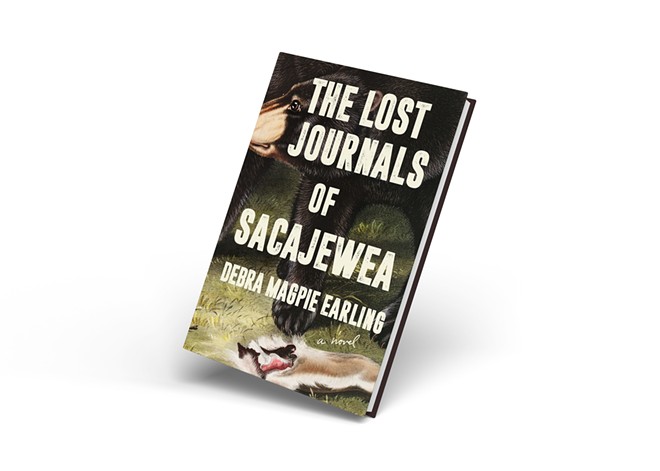Little is known about Sacajewea's actual life.
What's been pieced together from the journals of Lewis and Clark and other records often glorifies or dilutes the tragedies she and other Indigenous peoples endured as a result of colonial exploration.
Missoula-based author Debra Magpie Earling's new book, The Lost Journals of Sacajewea, tells Sacajewea's story from a first-person perspective that challenges many things previously thought to be fact.
"She has many different kinds of interpretations [of her], and there's oral histories about her life from different tribes, including my own," says Earling, who is Bitterroot Salish.
She'll be stopping in Spokane on Sept. 27 to discuss the book, released in May, with local readers.
While writing a response to the bicentennial in 2004 of the Lewis and Clark expedition for the Missoula Museum of Art and a later article for Alvin M. Josephy's anthology Lewis and Clark Through Indian Eyes, Earling's interest in Sacajewea was sparked and led her to question much of the historic information about her life.
"Non-Native historians have set a date of her birth at 1788, so that she would be 12 by the time she was abducted," Earling says, adding that would make Sacajewea 16 years old when she had her first child, although there's no evidence to support it.
Earling read Lewis' and Clark's journals and other records of the journey, noting that Sacajewea seemed to be younger than history states.
So in The Lost Journals of Sacajewea, Earling begins the story with Sacajewea at 9 years old.
"I began to look very closely at Clark, who had left Virginia when he started the Corps, and his fiancee, Judith, was 12 years old when he left Virginia," she says. "I think it was at Fort Clatsop where someone mentioned that Sacajewea is very young, and I thought, if they think she's young, then how old was she?"
Earling imagined the expedition through Sacajewea's eyes, envisioning the fear and hardships she would have endured throughout the arduous journeys she embarked on.
"[Sacajewea] was essentially an enslaved woman," she says. "She'd been sold or gambled to [Toussaint] Charbonneau, but history records [her] as being married to him."
The Lost Journals of Sacajewea is written as prose, narrating Sacajewea's thoughts and interactions with an air of fluidity, while simultaneously evolving and changing as she gets older and becomes more fluent in English.
"I throw the reader in without any handrails or a glossary to explain words," Earling says. "I throw them in like Sacajewea was kind of thrown into a totally different environment, one that was very frightening to her."
Earling also wrote The Lost Journals of Sacajewea with a speed and style that changes as the story progresses to reflect the swift rate at which colonialism occurred.
"The story kind of continues to accelerate as you get to the final pages," she says. "[It] kind of mimics the ways in which the European world entered Native life. It was slow at first and then became a really rapid digression, a rapid seizure of lands."
She notes how understanding Sacajewea's story and experience is important to understanding current issues, such as the crisis of missing and murdered Indigenous women and girls.
"Native women were terribly abused and murdered at astonishing kinds of rates and ended up missing or abducted," she says. "If we look through the lens of history, we can see where that kind of treatment toward Native women begins."
Earling's interest in writing stories about Indigenous women and "the ways in which Native women have really survived and upheld certain traditions" are apparent in both The Lost Journals of Sacajewea and her prior novel, Perma Red, which tells the story of an Indigenous girl named Louise who, like Sacajewea, insists on her own sovereignty.
Sacajewea, upon returning home to her Lemhi Shoshone people, reunited with a man from her tribe named Blue Elk. The two were betrothed as children, yet upon seeing her with her baby, Toussaint Charbonneau's son, Blue Elk refused to marry her for having a child with a white man, essentially cutting her off from her people, says Earling.
"At that point she became a sovereign woman," Earling says. "She said, 'I am going to see the whales, I'm going to see the ocean,' and she would not be moved from that. She made a decision to be her own person."
Earling, rather than focusing on the expedition or the cultures of the different tribes involved in Sacajewea's story, wanted the novel to primarily revolve around the personal experiences of her life.
"While I was writing the story, I was so imbued with the times, with what was going on, and with [Sacajewea's] sense of urgency to return to her people, and her sense of urgency to protect her child and to survive," Earling says. "It was just a remarkable writing journey."
Earling, who retired from teaching at the University of Montana last year, will be joined by her past student Sharma Shields and by Gonzaga University professor and novelist Shann Ray at the Central Library to read and discuss The Lost Journals of Sacajewea.
"For everybody interested in seeing a view of the world of Sacajewea that is totally different than the Western colonized view, this book establishes a very unique and profound vision of the kind of courage, the kind of sacrifice and the kind of love that is able to transcend genocide," Ray says. "It's experimental, it's lyrically exquisite, it's unlike anything anybody's read before." ♦
Debra Magpie Earling: The Lost Journals of Sacajewea • Wed, Sept. 27 at 6 pm • Free • Central Library, Events Room A • 906 W. Main Ave. • spokanelibrary.org


